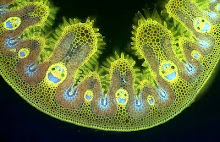Thursday, January 6, 2011
Golden Hop, Humulus lupulus aureus
Hops have been cultivated in Britain for flavouring beer since the sixteenth century – and for much longer in continental Europe – thanks to the resins produced at the base of the bracts in the female flowers (seen in the picture here), which are converted to bitter isohumulones during the brewing process. There are separate male and female hop plants but in modern times only female hops (with the cone-like flowers in the photo here) have been cultivated, as the seeds are undesirable in the brewing process.
My reason for growing hops (the golden-leaved variety) is rather more prosaic. Hops are rapid climbers with incredibly tough stems and for about a decade it was only the covering of hops woven around the fence posts that kept the fence at the bottom of our garden upright, after the posts had rotted at the base.
Charles Darwin was fascinated by climbing plants and during one of his bouts of (probably psychosomatic) illness took to his bed and had hops in pots brought into his bedroom, so he could wile away the hours studying the climbing process in this plant. He recorded his observations in detail in his book The Movements and Habits of Climbing Plants , published in 1875, in his usual precise prose.
“ When the shoot of a Hop (Humulus lupulus) rises from the ground," he wrote,"the two or three first-formed joints or internodes are straight and remain stationary; but the next- formed, whilst very young, may be seen to bend to one side and to travel slowly round towards all points of the compass, moving, like the hands of a watch, with the sun. The movement very soon acquires its full ordinary velocity. From seven observations made during August on shoots proceeding from a plant which had been cut down, and on another plant during April, the average rate during hot weather and during the day is 2 hrs. 8 m. for each revolution; and none of the revolutions varied much from this rate. The revolving movement continues as long as the plant continues to grow; but each separate internode, as it becomes old, ceases to move.”
Darwin was describing the process that botanists refer to as circumnutation, where the shoot tip describes a wide circle until it touches something that it can coil around (clockwise, in the case of hops). He went on to time the rotations of a hop shoot over no less than thirty seven rotations, testament to Darwin’s incredibly meticulous approach to making scientific observations that can, regrettably, make some of his books somewhat tedious to the modern reader. Still, the mental picture of Darwin laying in bed, carefully timing the rotations of hop shoot tips with his watch, does have a considerable charm.
You can find some further information on hop epidermal hairs used in climbing and also hop resin glands by clicking here.
Labels:
Cannabaceae,
Golden Hop,
Humulus lupulus aureus














